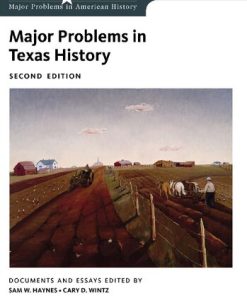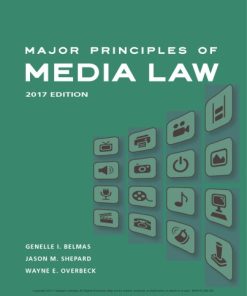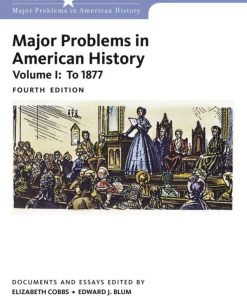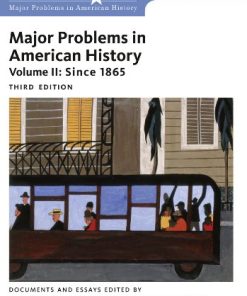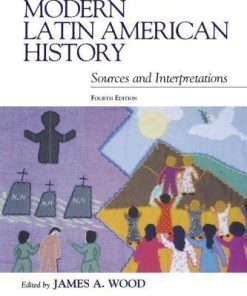Major Problems in American History, Volume I
$50.00 Original price was: $50.00.$25.00Current price is: $25.00.
Major Problems in American History, Volume I – Digital Instant Dowload.
Major Problems in American History, Volume I – Digital Instant Dowload.
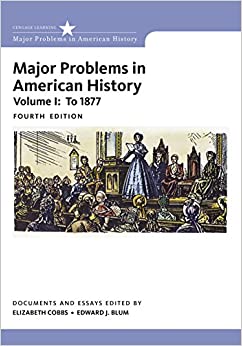
Product details:
- ISBN-10 : 1305585291
- ISBN-13 : 978-1305585294
- Author: Elizabeth Cobbs Hoffman
Designed to encourage critical thinking about history, the MAJOR PROBLEMS IN AMERICAN HISTORY series introduces you to both primary sources and analytical essays on important topics in U.S. history. This collection serves as the primary anthology for the introductory survey course, covering the subject’s entire chronological span. Comprehensive topical coverage includes politics, economics, labor, gender, culture, and social trends. The fourth edition has been revised to reflect two new historiographical trends: the emergence of the history of religion as an exceptionally lively field and the internationalization of American history. Several chapters include images, songs, and poems to give you a better feel for the time period and events under discussion. Key pedagogical elements of the Major Problems format have been retained: chapter introductions, headnotes, and suggested readings.
Table contents
1. CONQUEST AND COLLIDING WORLDS. Documents.
1. The Iroquois Describe the Beginning of the World, n.d.
2. The Portuguese Describe Battles with West Africans,
1448.
3. Christopher Columbus Recounts His First Encounters with Native People,
1493.
4. Fray Bernardino de Sahagun Relates an Aztec Chronicler’s Account of the Spanish Conquest of the Aztecs,
1519.
5. A European Artist Illustrates a Smallpox Outbreak among Nahau Indians,
1585.
6. English Artist John White Depicts Indian Land Use,
1619.
7. Reverend John Heckewelder Records a Native Oral Tradition of the First Arrival of Europeans on Manhattan Island (1610),
1818.
8. William Wood Describes Indian Responses to the English,
1634. Essays. James H. Merrell, The Indians’ New World. Neal Salisbury, The Indians’ Old World.
2. THE SOUTHERN COLONIES IN BRITISH AMERICA. Documents.
1. Edward Waterhouse, a British Official, Recounts an Indian Attack on Early Virginia Settlement,
1622.
2. Indentured Servant Richard Frethorne Laments His Condition in Virginia,
1623.
3. George Alsop, a Resident of Maryland, Argues That Servants Profit from Life in the Colonies,
1666.
4. Nathaniel Bacon, Leader of a Rebellion, Recounts the Misdeeds of the Virginia Governor,
1676.
5. Virginia’s Statutes Illustrate the Declining Status of African American Slaves, 1660-1705.
6. Southern Planter William Byrd Describes His Views Toward Learning and His Slaves, 1709-1710.
7. Illustration of Slaves Cultivating Tobacco,
1738.
8. African Olaudah Equiano Recounts the Horrors of Enslavement,
1757. Essays. Kathleen M. Brown, The Anxious World of the Slaveowning Patriarch. Philip D. Morgan, The Effects of Paternalism Among Whites and Blacks.
3. COLONIAL NEW ENGLAND AND THE MIDDLE COLONIES IN BRITISH AMERICA. Documents.
1. Puritan Leader John Winthrop Provides a Model of Christian Charity,
1630.
2. Anne Bradstreet Discusses Her Children in the Colonies,
1656.
3. Mary Rowlandson, A New England Woman, Recounts Her Experience of Captivity and Escape from the Wampanoag During King Philip’s War,
1675.
4. Proprietor William Penn Promotes His Colony,
1681.
5. Examination and Testimony of Tituba, a Servant-Slave in Salem, Massachusetts,
1692.
6. A Slave, Phillis Wheatley, Laments the Death of Revivalist George Whitefield,
1770.
7. Dr. Alexander Hamilton Depicts the Material Acquisitions of Northern Colonists,
1744.
8. Gottlieb Mittelberger, a German Immigrant, Portrays the Difficulties of Immigration,
1750. Essays. David D. Hall, Worlds of Wonder in the Northern Colonies. T. H. Breen, Worlds of Goods in the Northern Colonies.
4. THE AMERICAN REVOLUTION. Documents.
1. The Stamp Act Congress Condemns the Stamp Act,
1765.
2. Virginian Patrick Henry Warns the British to Maintain American Liberties,
1775.
3. Pamphleteer Thomas Paine Advocates the “Common Sense” of Independence,
1776.
4. Abigail and John Adams Debate Women’s Rights,
1776.
5. A Song to Inspire Revolution,
1776.
6. Mohawk Leader Joseph Brant Commits the Loyalty of His People to Britain,
1776.
7. African Americans Petition for Freedom,
1777.
8. General Washington Argues for Greater Military Funding by Portraying the Plight of Soldiers at Valley Forge,
1778. Essays. Gordon S. Wood, Radical Possibilities of the American Revolution. Gary B. Nash, The Radical Revolution from the “Bottom Up.”
5. THE MAKING OF THE CONSTITUTION. Documents.
1. The Articles of Confederation Stress the Rights of States,
1781.
2. Cato, an African American, Pleads for the Abolition of Slavery in Pennsylvania,
1781.
3. Slaveholders in Virginia Argue Against the Abolition of Slavery, 1784-1785.
4. Thomas Jefferson Proposes the Protection of Religious Freedom in Virginia,
1786.
5. Daniel Shays and Followers Declare Their Intent to Protect Themselves Against “Tyranny,”
1787.
6. Generals William Shepard and Benjamin Lincoln Regret the Disorder That Characterized Shays’s Rebellion,
1787.
7. The Federalist Papers Illustrate the Advantages of Ratification of the Constitution, 1787-1788.
8. Patrick Henry Condemns the Centralization of Government If the Constitution Is Ratified,
1788.
9. George Washington Promises Freedom of Religion for Jewish People,
1790. Essays. Alfred F. Young, The Pressure of the People on the Framers of the Constitution. Jack N. Rakove, The Hope of the Framers to Recruit Citizens to Enter Public Life.
6. COMPETING VISIONS OF NATIONAL DEVELOPMENT IN THE EARLY NATIONAL PERIOD. Documents.
1. Republican Thomas Jefferson Celebrates the Virtue of the Yeoman Farmer,
1785.
2. Judith Sargent Murray Argues for the “Equality of the Sexes,”
1790.
3. Federalist Alexander Hamilton Envisions a Developed American Economy,
1791.
4. Federalists Represent Democratic-Republicans as Secretive, Arrogant, and Rude,
1793.
5. C. William Manning, a Republican, Fears for the Future of the Nation,
1798.
6. Thomas Jefferson Advances the Power of the States,
1798.
7. Chief Justice John Marshall Argues for the Primacy of the Federal Government,
1803.
8. Tom Paine Eulogizes George Washington,
1800. Essays. Linda K. Kerber, The Fears of the Federalists. Drew R. McCoy, The Fears of the Jeffersonian Republicans.
7. FOREIGN POLICY, WESTWARD MOVEMENT, AND INDIAN REMOVAL IN THE EARLY NINETEENTH CENTURY. Documents.
1. President George Washington Warns Against “Entangling Alliances,”
1796.
2. William Clark of the Lewis and Clark Expedition Enters into Diplomacy with Native People,
1806.
3. Iroquois Chief Red Jacket Decries the Day When Whites Arrived,
1805.
4. William Cullen Bryant Satirizes the Embargo Act, 1808 .
5. Shawnee Chief Tecumseh Recounts the Misdeeds of Whites and Calls for Indian Unity,
1810.
6. Tenskwatawa (The Prophet) Relates His Journey to the World Above,
1810.
7. President James Monroe Declares That European Powers May Not Interfere in the Americas,
1823.
8. The Cherokee Nation Pleads to Remain “on the Land of Our Fathers,”
1830.
9. President Andrew Jackson Defends Indian Removal,
1833. Essays. Gregory Evans Dowd, Indians Utilizing a Strategy of Armed Resistance. Theda Perdue, Indians Utilizing a Strategy of Accommodation.
8. THE TRANSPORTATION, MARKET, AND COMMUNICATION REVOLUTIONS IN THE EARLY NINETEENTH CENTURY. Documents.
1. Slave Charles Ball Mourns the Growth of Cotton Culture and “Sale Down the River,” ca.
1800.
2. Chief Justice John Marshall Advances a Broad Construction of the Constitution, 1819,
1824.
3. President John Quincy Adams Urges Internal Improvements,
1825.
4. A Family in Illinois Struggles with Marketing Their Crops,
1831.
5. Harriet Hanson Robinson, a “Lowell Girl,” Describes Her Labor in a Textile Mill,
1831.
6. European Visitor Alexis de Tocqueville Considers the Influence of Democracy on the Family,
1831.
7. Author Charles Dickens Describes Travel on an Early Railroad Train,
1842.
8. A Guidebook Instructs Women on the Role of Mother,
1845.
9. South Carolina Governor James Henry Hammond Instructs His Overseer on Running the Plantation, c. 1840s. Essays. Nancy F. Cott, The Market Revolution and Changes in Women’s Work. Daniel Walker Howe, The Changes Wrought by Cotton, Transportation, and Communication.
9. NATIONALISM, SECTIONALISM, AND EXPANSIONISM IN THE AGE OF JACKSON. Documents.
1. A Song to Put Andrew Jackson in the White House, c. 1820s.
2. Vice President John C. Calhoun Argues That Tariffs Disadvantage the South,
1828.
3. Senator Daniel Webster Lays Out His Nationalist Vision,
1830.
4. President Andrew Jackson Condemns the Rights of “Nullification” and Secession,
1832.
5. President Andrew Jackson Vetoes the Bank Bill,
1832.
6. Lieutenant-Colonel Jose Enrique de la Pena Defends Mexico’s Actions Against the Texans,
1836.
7. Michel Chevelier, a French Visitor, Marvels at the Pageantry of Politics,
1839.
8. John L. O’Sullivan, a Democratic Newspaperman, Defines “Manifest Destiny,”
1845.
9. Walter Colton, a Californian, Describes the Excitement of the Gold Rush,
1848. Essays. Mary P. Ryan, Antebellum Politics as Raucous Democracy. Glenn C. Altschuler and Stuart M. Blumin � Antebellum Politics as Political Manipulation.
10. REFORM AND THE GREAT AWAKENING IN THE EARLY NINETEENTH CENTURY. Documents.
1. Peter Cartwright, a Methodist Itinerant Preacher, Marvels at the Power of Religious Revivals,
1801.
2. African American Abolitionist David Walker Castigates the United States for Its Slave System,
1829.
3. White Abolitionist William Lloyd Garrison Calls for Immediate Abolition,
1831.
4. A Description of the Prophet Matthias and His Attacks on Women,
1835.
5. Angelina Grimke Appeals to Christian Women to Oppose Slavery,
1836.
6. Reformer Dorothea Dix Depicts the Horrible Conditions Endured by the Mentally Ill,
1843.
7. Joseph Smith Records a Revelation on Plural Marriage,
1843.
8. The Seneca Falls Convention Declares Women’s Rights,
1848.
9. Former Slave Sojourner Truth Links Women’s Rights to Antislavery,
1851. Essays. Paul E. Johnson, Religious Reform as a Form of Social Control. Nell Irvin Painter, Religion as Inhibiting and Liberating: The Complicated Case of Sojourner Truth.
11. COMMERCIAL DEVELOPMENT AND IMMIGRATION IN THE NORTH AT MIDCENTURY. Documents.
1. Alexis de Tocqueville Marvels at the Mobile Northern Society,
1831.
2. Inventor Samuel F. B. Morse Fears That Immigrants Will Ruin American Inequality,
1835.
3. Essayist Orestes Brownson Condemns the Plight of “Wage Slaves,”
1840.
4. Gustof Unonius, a Swedish Immigrant, Reflects on Life in the United States, 1841-1842.
5. A Lowell Factory Girl Describes a Week in the Mill,
1845.
6. New Yorker George Templeton Strong Berates the Immigrants in His Midst, 1838-1857.
7. James Bowlin, a Congressman, Marvels at the Possibilities of Western Lands,
1846.
8. Irish Americans Sing About Their Struggles and Successes, c. 1860s. Essays. David R. Roediger, White Slaves, Wage Slaves, and Free White Labor in the North. John Ashworth, Free Labor and Wage Labor in the North.
12. AGRICULTURE AND SLAVERY IN THE SOUTH AT MIDCENTURY. Documents.
1. A North Carolina Law Prohibits Teaching Slaves to Read or Write,
1831.
2. Samuel Cartwright, a Southern Doctor, Theorizes About the Peculiar Diseases of Slaves,
1851.
3. Virginian George Fitzhugh Argues That Slavery Is a Positive Good That Improves Society,
1854.
4. African American Josiah Henson Portrays the Violence and Fears in Slave Life,
1858.
5. Southern Author Daniel Hundley Robinson Depicts the White Yeoman Farmer,
1860.
6. Harriet Jacobs Deplores Her Risks in Being a Female Slave,
1861.
7. Southerner Mary Chestnut Describes Her Hatred of Slavery from a White Woman’s View,
1861.
8. Northerner Frederick Law Olmsted Depicts the Economic Costs of Slavery,
1861.
9. Three Slave Songs Recorded by Whites,
1867. Essays. Walter Johnson, Slaves and the “Commerce” of the Slave Trade. Anthony E. Kaye, The Neighborhoods and Intimate Lives of Slaves.
13. CAREENING TOWARD CIVIL WAR. Documents.
1. Senator John C. Calhoun Proposes Ways to Preserve the Union,
1850.
2. Frederick Douglass Asks How a Slave Can Celebrate the Fourth of July,
1852.
3. Reviewers Offer Differing Opinions About Uncle Tom’s Cabin,
1852.
4. Axalla John Hoole, a Southerner, Depicts “Bleeding Kansas,”
1856.
5. Senator Charles Sumner Addresses the “Crime Against Kansas,”
1856.
6. Chief Justice Roger Taney Determines the Legal Status of Slaves,
1857.
7. Senate Candidates Abraham Lincoln and Stephen Douglas Debate Their Positions on Slavery,
1858.
8. Republican William Seward Warns of an Irrepressible Conflict,
1858.
9. Abolitionist John Brown Makes His Last Statement to the Court Before Execution,
1859.
10. The Charleston Mercury Argues That Slavery Must Be Protected,
1860. Essays. Michael F. Holt, The Political Divisions That Contributed to Civil War. Bruce Levine, The Economic Divisions That Contributed to Civil War.
14. THE CIVIL WAR. Documents.
1. Senator Robert Toombs Compares Secession with the American Revolution,
1860.
2. Frederick Douglass Calls for the Abolition of Slavery,
1862.
3. Margaret Junkin Preston Describes Southern Suffering in Her Diary,
1862.
4. James Henry Gooding, an African American Soldier, Pleads for Equal Treatment,
1863.
5. Tally Simpson, a Confederate Soldier, Recounts the Battle of Gettysburg,
1863.
6. Mary A. Livermore, a Northern Woman, Recalls Her Role in the Sanitary Commission,
1863.
7. Two Artistic Representations of Emancipation, 1863,
1864.
8. Congressman Clement Vallandigham Denounces the Union War Effort,
1863.
9. President Abraham Lincoln Calls for Peace and Justice in His Second Inaugural Address,
1865. Essays. James M. McPherson, The Role of Abraham Lincoln in the Abolition of Slavery. Ira Berlin et al., The Role of African Americans in the Abolition of Slavery.
15. RECONSTRUCTION, 1865-1877. Documents.
1. William Howard Day, an African American Minister, Salutes the Nation and a Monument to Abraham Lincoln,
1865.
2. A Southern Song Opposes Reconstruction, c. 1860s.
3. Louisiana Black Codes Reinstate Provisions of the Slave Era,
1865.
4. President Andrew Johnson Denounces Changes in His Program of Reconstruction,
1867.
5. Congressman Thaddeus Stevens Demands a Radical Reconstruction,
1867.
6. Representative Benjamin Butler Argues That President Andrew Johnson Be Impeached,
1868.
7. Elizabeth Cady Stanton Questions Abolitionist Support for Female Enfranchisement,
1868.
8. Lucy McMillan, a Former Slave in South Carolina, Testifies About White Violence,
1871.
9. Father Abram Ryan Proclaims Undying Love for the Confederate States of America,
1879.
10. Francis Miles Finch Mourns and Celebrates Civil War Soldiers from the South and North,
1879. Essays. Steven Hahn, Continuing the War: White and Black Violence During Reconstruction. David W. Blight, Ending the War: The Push for National Reconciliation.
You may also like…
History - American Studies
Major Problems in Texas History: Documents and Essays Second Edition Sam W. Haynes
Politics & Philosophy - Anthropology
The Norman Conquest in English History: Volume I: A Broken Chain? George Garnett
Politics & Philosophy - Anthropology
Major Problems in American History – Volume I: To 1877 4th Edition Elizabeth 9798214348018
Uncategorized
Problems in Modern Latin American History: Sources and Interpretations, – Ebook PDF Version
Fiction - Essays




